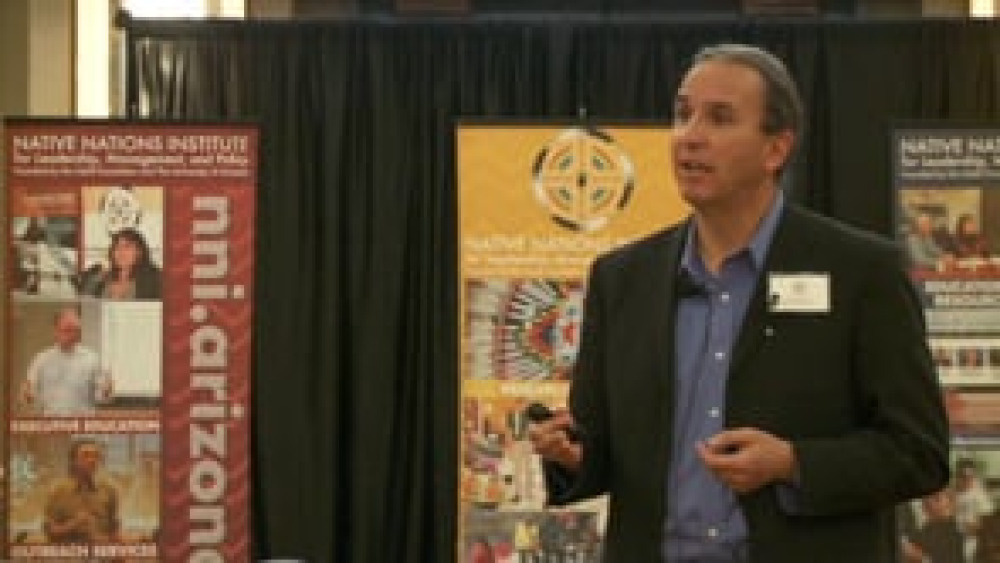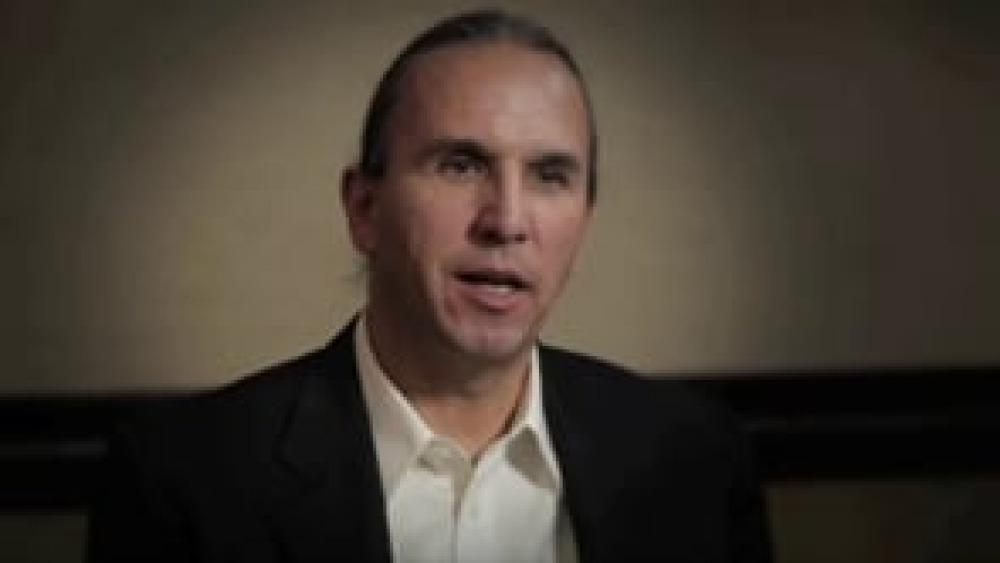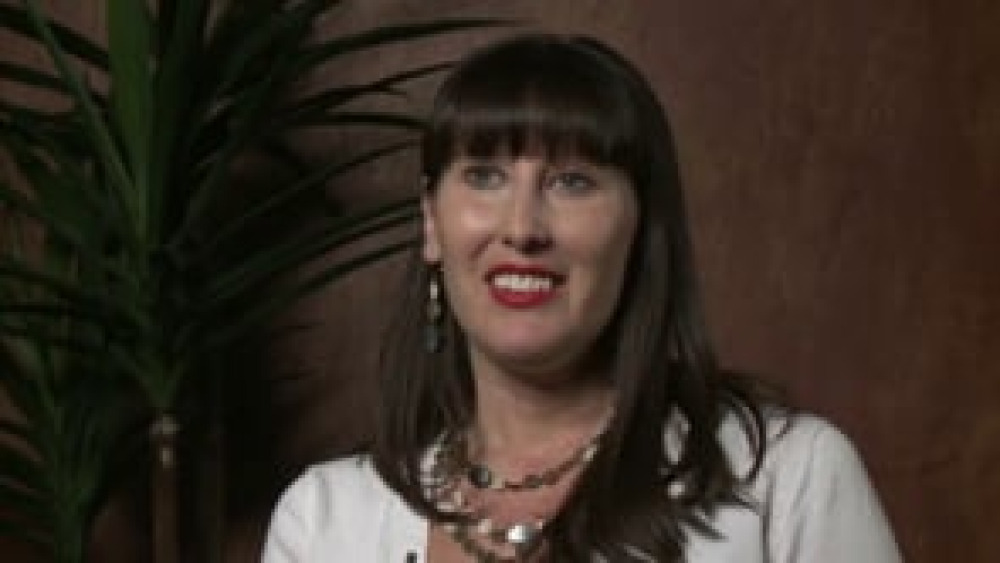White Earth Nation Chairwoman Erma Vizenor discusses some of the historical factors that eventually compelled her and her nation to undertake constitutional reform, and the issues her nation has encountered as they work to ratify a new constitution and governance system.
Additional Information
Vizenor, Erma. "Engaging the Nation's Citizens: The White Earth Nation Story." Emerging Leaders seminar. Native Nations Institute for Leadership, Management, and Policy, University of Arizona. Tucson, Arizona. March 25, 2010. Presentation.
Transcript
"Good morning. At home we say, '[Anishinaabe language].' Good morning. I want to thank everyone for being here, and to come to such a beautiful place. I came in late last night, so all I saw as the cab was driving me in was this huge place with all kinds of lights. And I was so anxious to see it this morning and it's gorgeous. Your home, your beautiful home, yes. I'm just sorry I can't stay very long today, but I want to thank my dear friend Manley Begay for inviting me to this seminar. He contacted me at least two-and-a-half, three months ago, and of course I checked off the date and made sure that I had this time open. So Manley and I, way, way back we started our doctoral program together at Harvard. This is kind of funny because this is how things happen but we were just overwhelmed with everything and we were also changing Harvard at the same time, because I know that we worked hard to get the Harvard [University] Native American Program as it is today. So we were overwhelmed with all of our doctoral studies and Manley and I said, we were sitting there and he said, ‘Yeah, we're going to go home in three years. We're going to go back where we belong.' Well, Manley stayed on at Harvard for 12 or 13 years doing good work at the Kennedy School of Government. I went home after three years and I got into a reform movement to oust corruption in my tribe and I did that for five years. All good work, necessary work. We didn't leave as we should. The day that I...or a week after the indictments came against three council members for bid rigging, election fraud, embezzlement theft, all kinds of crimes, a week after that I received a letter from Harvard. The letter said, ‘You come back and finish your dissertation or else by the end of...by the spring of 2006 we're going to drop you.' So I jumped on the plane and went back to Harvard and worked very hard, had to do everything over again, and I didn't write a masterpiece but I finished my dissertation and graduated that spring.
We as Indian people, I just want to say and commend all of you because most of us have to run twice as hard, work twice as hard, run twice as fast to keep up and that's the way it is. I don't think anything comes easy for us. I want to say that I am...say a little bit about the White Earth tribe. We are called; the federal government calls us the White Earth Band of Ojibwe Indians. I have gotten, I have worked hard to get our people -- although when we sign our documents with the federal government I have to use that name -- but amongst ourselves we call ourselves a nation because that's what we are. We always have to remember that we are what we call ourselves. I say to our people back home, ‘A band? My goodness, we're a nation of many bands and we think about a band -- loose, disorganized, small. We're more than that, we're a nation.' And so the White Earth Nation is located in northern Minnesota. We're one of 11 tribes, seven Ojibwe tribes and four Dakota Sioux tribes in the southern half of the state. White Earth is the largest tribe. We have 20,000 members and we're part of the Minnesota Chippewa Tribe, which is White Earth, Leech Lake, Fond du Lac -- and I know Chairwoman Diver was here yesterday -- Grand Portage, Bois Forte and Mille Lacs. We comprise the Minnesota Chippewa Tribe, which is an IRA [Indian Reorganization Act] structure created in 1936. The Red Lake Nation is not a part of the Minnesota Chippewa Tribe. The Red Lake Nation is Ojibwe -- and we have a good relationship with Red Lake -- but Red Lake is unique. It's a closed reservation because they didn't participate in the Allotment Act, the Dawes Act. They kept all their land in common and didn't allow...didn't participate so the land was not allotted and consequently lost. Wise chiefs in those days.
That did not happen to White Earth. White Earth was allotted all out and White Earth...and Red Lake by the way was the federal government's solution to the Indian problem in Minnesota and created these two large reservations to move all the Indians in Minnesota to the Ojibwe Indians, Chippewa Indians to these two reservations. Relocate the Indians again and get them all together where we can oversee and control them, but that didn't work because our Indian people did not leave their homelands and so we still have our reservations up of Fond du Lac and Mille Lacs and Leech Lake and Bois Forte. People went home again, even if some of them did come to White Earth. So that didn't work, but White Earth is the largest tribe because many of the different Ojibwe people came to White Earth. And the land was allotted out at White Earth and consequently because of that allotment process the land was lost, it was swindled, it was theft, it was lumber companies and farmers and people who were homesteading. So our land was lost. We had...our reservation was established in 1867 and comprised approximately 850,000 acres of land. By the 1900s, we had 50,000 acres of land left. The rest was lost. So land acquisition is a huge priority, large priority for us. Today, when the federal government organized the Minnesota Chippewa Tribe, the six reservations together, it put all of our land in common. We have approximately 60,000 acres of land at White Earth out of the 850,000 acres. That's in tribal trust land and it's under the ownership of the Minnesota Chippewa Tribe in common. I worked hard to get that back and some of the tribal leaders want to be paid out within the Minnesota Chippewa Tribe and I tell them, ‘I don't see your tribe in our treaty.' But that's the federal government creating these problems for us as Indian people.
The governance of the Minnesota Chippewa Tribe is an IRA constitution adopted in 1936 and is a very...since 1987...Vernon Bellecourt was a White Earth secretary/treasurer and was a very progressive man. He initiated a resolution that the Minnesota Chippewa Tribe conduct a constitutional convention. I admire Vernon because he was a visionary person. And in 1987, the Minnesota Chippewa Tribe passed that resolution but it never to this day has not held a constitutional convention. Well, we have an IRA constitution and it's very, very difficult for our people -- how many of us read our state constitutions or our United States Constitution and figure out what our rights...how many of us do that? We know it is taught in our schools, but our constitutions are not taught. And so when I came back from Harvard after I finished my classes, we had corruption in our tribe at White Earth, huge corruption. Our elections were fraudulent, we had bid rigging, and so I worked with elders on a grassroots reform movement and I spent the entire summer of 1991 in jail because we had all of this corruption. By 1995, and with the help of the late Senator Paul Wellstone, an investigation was done and indictments were issued and consequently a federal court trial. This grassroots movement really involved a lot of people at home and got them engaged.
When I was at Harvard, I studied the...Manley and I and Colleen Larimore, we did a paper together on community organizing. And so I learned some good skills there and so we engaged, I engaged the community, the reservation, which is a large area. It's a square that's 36 miles on each side and a lot of our people live in Minneapolis/St. Paul and they came up to help. So we had this huge momentum and change had to come and the people were, the people were empowered to make that change. We had to have open meetings every night, every night we had open meetings and it was spiritual because we had our spiritual people there and we always gathered around to pray first and we always said that we need the Creator to help us.
So in 1996 I was appointed the secretary/treasurer, which is the second role in government and I was elected to that position and re-elected in 1998. I lost my election in 2002. I lost it. But I ran on the platform of constitutional reform. Other tribal leaders run on it but don't do anything about it. But I did. I put together a committee and in 1997, '99 the committee drafted a constitution, I took it out to the reservation, to the Minneapolis area, and very few people showed up. It was a very, very difficult constitution to understand because it was...it talked about grand councils and it talked about language that we had never experienced before. And so when I lost the election in 2002, the constitution went off the radar screen, many things went off, went to the bottom of the drawer. I ran for election for the tribal chair in 2004 in the primary and I won the primary, beat the incumbent and constitutional reform was back on the radar screen again. And so we have, I facilitated, I organized and I facilitated all of the constitutional convention process from delegates, kept the entire process totally transparent and we drafted a constitution and we ratified it by the delegates about a year ago.
And then because...I say we're part of the Minnesota Chippewa Tribe with this IRA constitution, I've gone to the...now I'm at the Minnesota Chippewa Tribe level and I'm getting stalled. Some tribes don't want to change, and I think it's because of the colonization and the institutional oppression that people haven't come out of yet. I really do. Don't see the need to change, don't see the need to. There are some issues that are huge. The blood quantum issue is a huge issue, very controversial. Well, that's one of the most controversial ones is the blood quantum and in our new constitution we...our delegates voted on lineal descent. We are terminating ourselves, people, if we cooperate with the federal government on one-fourth blood quantum. We just need to do the math and pretty soon within...we think of seven generations, by seven generations most of us will be gone. That's a controversial issue and even our tribal members in our constitutional conventions get to the point where they say...they get into ethnic cleansing. We have African...our tribal members have married to African-Americans and look like African-Americans and they don't want them there because they're black. I say, ‘My goodness, ethnic cleansing? I can't believe that.' But that's where we're at sometimes. I want to just...I know I don't have a lot of time, but I want to just stop right now and turn it over. Thank you very much.



